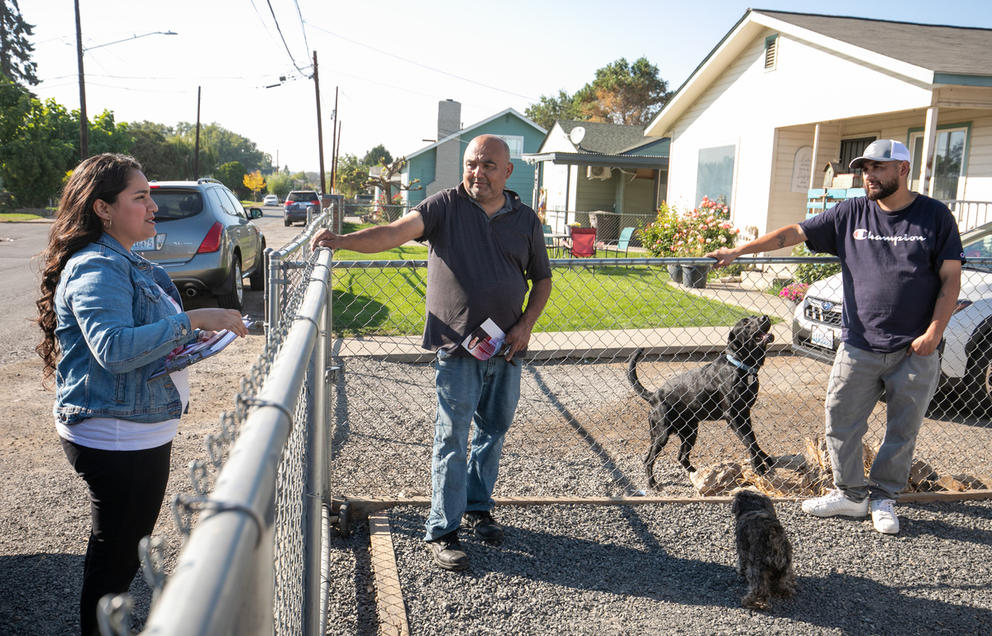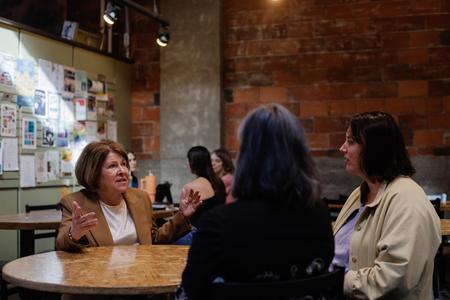Podcast | Central WA Latino voters shift rightward, data suggests
Pundits and politicians were hyper-focused on this electorate leading up to the midterms. Now that the dust has settled, we explore what actually happened.

Dulce Gutierrez, Democratic candidate for Yakima County Commissioner, District 2, meets with voters Casimiro Pardo, center, and his son Erick Pardo, right, on Sat., Oct. 15, 2022, as she canvases in Yakima. (TJ Mullinax/Crosscut)
By the time the polls closed in Washington state on the evening of Nov. 8, the narrative was set. The “Red Wave” predicted by many pundits and politicians did not materialize. Bucking historical trends for midterm elections – and the electorate’s negative feelings toward the sitting president – Democrats were well-positioned to hold their Senate majority and to lose the House by only a very small margin. Three weeks later, those storylines have held as the conversation turns from pursuing power to wielding it.
As often happens in U.S. democracy, the storylines that came before Election Day can feel like ancient history. Among those storylines: the fight for the Latino vote.
As we noted in the previous episode of the Crosscut Reports podcast, there was a lot of consternation over the Latino vote. Who the people who made up this growing part of the electorate decided to vote for, we were told, could tip the scales and help determine the balance of power in Washington, D.C. There was also the question of what impact Latino voters would have on local races in Central Washington, including one in which Democrat Dulce Gutierez was running to be the first Latina elected to the Board of Yakima County Commissioners.
Of course, the story of the Latino vote didn’t end when that balance of congressional power was settled. And early data tells a story that is more complicated than the no-wave narrative and potentially more troubling for Democrats.
For this episode of the Crosscut Reports podcast, we look at the data from Washington state to discern what exactly happened with the Latino vote, and we examine Gutierrez’s bid for history and discuss where the fight for Latino representation goes from here.
This story and podcast episode were reported by Mai Hoang and Sara Bernard. Listen to Crosscut Reports on Apple Podcasts, Spotify, Amazon or wherever you get your podcasts.
Washington was not an outlier in the midterms. U.S. Senator Patty Murray, the Democratic incumbent, won reelection easily in the end, despite what appeared to be a late surge from her Republican opponent, Tiffany Smiley. And Democratic candidates won both Congressional races that were considered, at one point or another, toss-ups: the 3rd and the 8th.
But in Central Washington, where several counties are majority-Hispanic or -Latino, it’s worth noting that Democrats did not do well, according to early voter data. Political consultant Ben Anderstone has been poring over this data and says some of that outcome is likely to have come from Latino voters.
“There are some variables that we're gonna have to look at, but I do think there's some early signs in Washington that both the Latino and Asian American vote probably did … swing a bit toward the Republicans,” said Anderstone, who crunches numbers like these for Democrats in his job at Progressive Strategies Northwest, including working with the Gutierrez campaign for this election cycle.
Anderstone explained that the swing was pretty dramatic. For instance, in the previous midterm election, in 2018, when Democratic Senator Maria Cantwell was on the ballot, she lost in Yakima County by 16 points. At the time of our interview, Murray was down by 30 points. In Franklin and Pasco counties, both of which have a large Latino electorate, Republican support in the Senate race had swung toward Republicans by 20 points.
“There's still some questions about how much of that was turnout, but my strong guess is not all of it,” Anderstone said. “I think it's pretty obvious that there's probably some Latinos who ended up voting Republican this year.”
The precinct-level data deepens that narrative. East Yakima, the part of Yakima with the highest percentage of Hispanic residents, saw a decrease in votes for both parties compared to the 2018 midterm election, but a far bigger decrease in votes for the Democratic candidate for U.S. Senate at the time: 9 percent versus 42 percent. A similar story happened in majority-Hispanic Pasco and East Pasco: In the Senate race, those precincts saw an 8 percent increase in the Republican vote versus a 46 percent decrease in the Democratic vote.
There is some early evidence that this didn’t happen only in Washington and that some Latino voters are continuing to move to the right. CNN exit polls suggest that Republicans had their best year with Latino voters since 2004. The Democratic lead among Latino and Hispanic voters has shrunk by almost half since the previous midterm election.
More data will eventually clarify how exactly the Latino vote broke down, but these early reports suggest that the fight for Latino votes could very well return as a storyline for the 2024 election.




